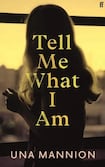
Una Mannion’s second novel, Tell Me What I Am, comes two years after her debut novel, A Crooked Tree, consolidated her reputation as a writer of great promise. Mannion had already won the Hennessy New Irish Writing Poetry Award and the Cúirt International Short Fiction Award before her debut novel won the Kate O’Brien Award in 2022.
Tell Me What I Am is a sure-footed and emotionally complex second novel which focuses on many of the same themes as her debut – family, loss, grief and identity.
Tell Me What I Am begins at the end, with 18-year-old Ruby Chevalier receiving an unexpected phone call from her aunt, Nessa. Ruby hasn’t seen or spoken to her aunt since her mother Deena (Nessa’s sister) disappeared 14 years earlier and Ruby’s father Lucas broke all ties with the family.
Within a matter of pages, Mannion has drip-fed the reader such intriguing details and characters that we are immediately invested. Mannion continues to build her authentic world through the use of detailed, but never lengthy, observations. Small particulars of ordinary life add verisimilitude: a dead chick in a box of hatched eggs; documentaries on TV; the intricate outfit someone wore to school that day.
‘Forget about glamour’: Jonathan Anderson offers advice to would-be fashion designers as he receives TCD honour
Death of Pope Francis: Derek Mooney leads RTÉ’s coverage to intermittently jaw-dropping effect
Chob Thai restaurant, Clontarf: The most memorable thing here is the bill
Careless People: The controversial book is shocking and reveals Facebook is far worse than we could have suspected
Like A Crooked Tree before it, Tell Me What I Am is a coming-of-age story as we follow Ruby from her happy early life through the traumatic disappearance of her mother to her present life with her controlling father. She also gives us a neatly braided secondary and more adult coming-of-age story with Nessa, whose emotional life has been amputated by the loss of her sister and niece. Through Nessa and her extended family, Mannion offers a mosaic view of how grief and trauma radiate through the lives of those left behind.
The book is packed with themes, motifs and varying subjects, which could feel didactic but under Mannion’s influence they simply become the many small elements of a rich and full story. There is an enjoyable Irish-American strand, featuring J1 contractors and the use of a hurl to smash up a car. (Mannion is from Philadelphia and now living in Sligo.) Then there are more political strands ranging from open carry gun laws in Vermont, the family law system in the US and the difficult topic of domestic abuse and coercive control. Nessa’s inebriated challenge to men using a woman’s bathroom actually reads like a more general challenge to men who hurt women. “Tell them to stop, just stop taking over every f**king bit of everything. Just get back.”
While that all may sound like a rather grim story, Mannion softens the effect by making us fall in love with Ruby and Nessa, and even Lucas’s gruff mother Clover and her neighbour Adelaide. She is careful to alleviate the darkness with the kindnesses of friends, teachers, neighbours and extended family.
Like the story itself, Mannion’s writing evades easy categorisation as it straddles literary and genre fiction. Her language is beautifully descriptive while her story has all the pacy elements of a thriller – the missing woman, the tense sense of danger, a mystery to be solved. The book’s intellectual heart, however, lies in the question of what makes us who we are and can our identity ever be erased? “This is what oppressors do,” a classmate of Ruby’s says at one point when they are discussing slavery as part of an English assignment. “Taking away birth dates and connections to family and parents was on purpose. It was so they could erase identities and make people feel like they were nobody. And if you made them nobody, it was easier to abuse them.” Or is identity more like the palimpsests of Nessa’s public art projects, embedded ink that determinedly seeps through any attempt to overwrite it?
At times these pronouncements and metaphors can feel a little intrusive, and the story can ebb slightly when certain plot points require brief explanation, but these are fleeting moments as Mannion’s focus is always on her reader, and on moving the story forward. Indeed, she has what feels like an old-fashioned respect for story, and cleverly time hops between the past and the present to bring all the threads of her story together by the end of the book.
Mannion skilfully closes the circle of this story by beginning a new one in which her reader gets to prolong the enjoyment of these absorbing characters by imagining what their futures might hold.















